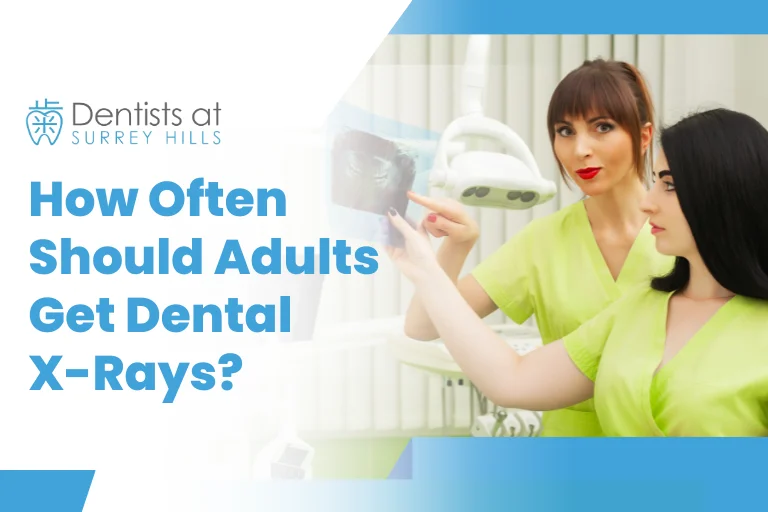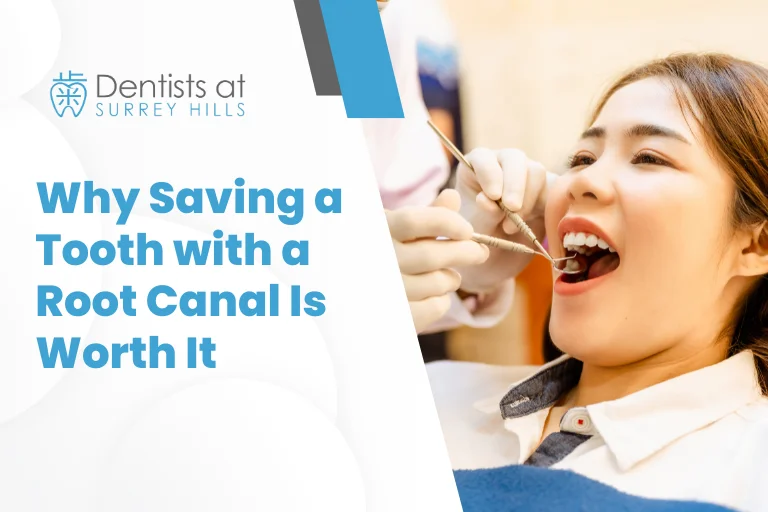In this article, we’ll talk about how often adults should get dental X-rays, why they’re needed, and what factors influence how frequently you might need them. We’ll also cover safety, common myths, and what Australian dental guidelines actually say, so you can make confident decisions about your oral health.
What Are Dental X-Rays, Anyway?
First up: what are we talking about. Dental X-rays (radiographs) are images that let dentists see what’s happening under the surface:
- between teeth where decay may start but you can’t see it
- under the gumline, including bone health
- roots of teeth, infections, abscesses
- wisdom teeth or teeth that are blocked or impacted
- assessing past dental work (crowns, fillings, etc.)
- sometimes checking jawbones, joints or planning for implants/orthodontics
In Australia, dental practitioners follow safety guidelines so the exposure to radiation is kept really low.
Safety: The Trade-Off
Any time radiation is involved, people (rightly) wonder about safety. But here’s the deal:
- Modern X-rays (especially digital ones) use very small doses.
- Dentists use protective gear when needed (thyroid collars, lead aprons if pregnant or if extra protection makes sense) and limit exposure.
- There are guidelines in place to make sure X-rays aren’t done more often than needed — the idea is always: benefit should outweigh risk.
So when dentists recommend an X-ray, it’s usually because they suspect something might be going on that they can’t see with just looking and poking.
What Influences How Often You Need X-rays
Here are the factors that change how frequently X-rays might be needed:
- Oral health status / risk profile
If you’ve got a history of cavities, disease, broken or repaired teeth, or you do things that put you more at risk (smoking, dry mouth, lots of sugar, etc.), you’ll likely need X-rays more often. - Age
Older folks often have more dental work, more wear and tear, more risk of bone loss — so dentists may want to monitor more closely. Also, cumulative effects. - Previous X-rays
If you already have recent, good quality X-rays, the dentist can sometimes just refer to them. If they’re older or low quality, new ones might be needed. - Symptoms / changes
If something’s changed — pain, swelling, problems, signs of decay, etc. — X-rays may be needed sooner rather than waiting. - Planned dental work
If you’re about to get something like a crown, implant or braces, or you need surgery, dentists may need clear images to plan. - Technology & quality
Modern digital X-ray machines are better, lower radiation, clearer images. If your dentist has good equipment, sometimes fewer X-rays are needed. Clean images mean less guesswork. - Pregnancy / special health considerations
If somebody is pregnant (or think they might be), or there are other health issues that affect risk, dentists may delay X-rays unless absolutely necessary, or take extra safety precautions.
Common Guidelines in Australia: What Dentists Usually Do
What does “how often” look like in practice for many adults in Australia? Of course, your dentist might adjust up or down depending on what applies to you, but here are typical intervals:
| Risk level / situation | How often dental X-rays might be taken |
| Adults with good oral health, low risk of decay, no symptoms | Every 2-3 years for bitewing (the kind that shows between teeth); full mouth / panoramic X-rays less often unless needed. |
| Adults with higher risk (history of cavities, gum disease, restorations, lifestyle risks) | More often — possibly every 12-18 months, or even every year if there are ongoing issues. |
| When there are symptoms or changes | Immediately or as soon as dentist thinks necessary — not waiting a scheduled interval. |
| When starting with a new dentist / no recent X-rays | Often a baseline set so they know what they’re working with. |
| For particular types of dental work (crowns, implants etc.) | Additional imaging to plan and monitor. |
| Pregnant or other special health status | Delay if possible; use protective measures; only if needed. |
Examples to Help Make Sense of It
To paint some pictures, here are hypothetical scenarios:
- You’re 35, brush/floss regularly, dental checkups every 6 months, never had a cavity, no restorations → You might get bitewing X-rays roughly every 2-3 years. If nothing shows up, you stick with that or maybe even less often.
- You’re in your 50s, have had crowns/fillings, sometimes more sugar in diet, gum health borderline → Might expect X-rays yearly or every 12-18 months to catch things early, especially between teeth or under older crowns.
- You’ve just moved dentists, and your records of X-rays are old or missing → Dentist may take a full mouth or panoramic image to get a good baseline.
- You notice pain, or swelling, or sensitivity that doesn’t go away → Dentist likely orders specific X-rays (root, periapical, etc.) as needed — no waiting for your “schedule.”
What the Official Guidelines Say
In Australia, several official bodies give guidance:
- ARPANSA (Australian Radiation Protection and Nuclear Safety Agency) has a code of practice / safety guide, which basically says all radiation exposure should be as low as reasonably achievable (the ALARA principle).
- The Australian Dental Association gives practical guidance: dentists should base X-ray frequency on your risk, previous fillings, disease history, etc. Not everyone needs X-rays every visit.
- General public-facing factsheets say the same: it depends on age, health, past X-rays, signs of disease.
Myths & Misconceptions
Just so you go in informed, here are some things people often assume — and why they’re not completely accurate.
- “Dentists want X-rays every 6 months just for extra money.”
Sometimes yes — but often no. If you’ve recently had good-quality images and your risk is low, dentists generally won’t push for them more than needed. The laws/regulations require justification. - “Any radiation is dangerous, so avoid all X-rays unless absolutely needed.”
Radiation does carry risk, but in dental X-rays it’s very low. Also, the cost of missing something like decay deep between teeth or bone loss can be much greater — pain, infection, more expensive fix later. - “If I don’t feel pain, nothing bad is happening.”
That can be dangerous thinking. A lot of dental issues creep up slowly without obvious symptoms. That’s why periodic imaging can catch issues before they become costly or painful. - “One full mouth X-ray covers me for years.”
Maybe, maybe not. If your mouth changes (new fillings, more wear, changes in gums or jaw), new X-rays may be needed even if you had one recently.
What You Can Do: Be Part of the Decision
You don’t have to just nod along when the dentist brings up X-rays. Here are steps to be confident about what’s going on:
- Ask why the X-ray is needed now. What do they expect to find, or what changed?
- Ask when the last good-quality X-rays were done. If recent ones are fine, you might not need new ones.
- Check if your risk level has changed. Started smoking? New meds that dry your mouth? New pain? All that matters.
- Discuss safety practices. Is the practise using digital X-rays? Are they using protective gear (especially in pregnancy)?
- Keep a copy of your images. If you move dentists, having your previous X-rays helps avoid duplication.
Bottom Line: What’s Reasonable
Putting it all together, for many healthy adults a rough schedule might look like:
- Bitewing X-rays every 2-3 years
- Full mouth / panoramic X-rays only when clinically needed (e.g. new dentist, planning treatment, signs of broader problems)
- More frequent imaging (maybe every 12-18 months or yearly) if you have greater risk or active dental issues
But — and this is key — it’s always personalised. Your dentist should tailor the schedule to you.Bonus Content:Dental X-Ray Cost in Melbourne




